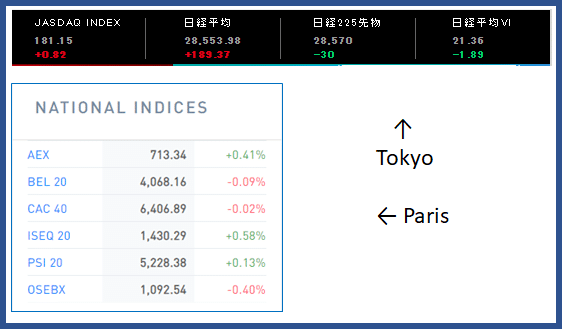
Introduction
In today’s world, almost any enterprise software application will be used by individuals in more than one country, speaking different languages, and in different cultural contexts.
So, enterprise software companies will need to address the localization challenge at some point.
In a perfect world, we would all design and build our products to be global from the beginning, but speed to market considerations will usually mean that the product is initially built for the home country.
A big part of the problem is retro-fitting localization onto an existing product, perhaps built recently but often built a while ago without the benefit of many of today’s built-in globalization capabilities.
Translation
I find that whenever someone refers to software localization, the first topic mentioned is always translation. Perhaps this is because language is the most obvious factor when communicating with people in different countries. Translation is now very well understood, and there are many tools available to help simplify and automate the process. Companies such as Lingoport enable the translation process to be a continuous, integrated part of the development process, rather than a post-development one. And this is one area of localization where Artificial Intelligence and Machine Learning are starting to have a positive impact.
Formatting
The second most common topic is formatting – displaying (and accepting) data in a way that the user expects, be that dates, numbers, times, names, etc. Again, the topic is well understood. Indeed, many of the capabilities are incorporated into the infrastructure that we use to build software – the operating system, database management system, programming languages, and web browsers.
Cultural factors
What is far less often talked about and less understood universally is what I refer to as the cultural factor: despite the globalization of business over the past 50 years, every country remains unique with its own sets of legal rules, business practices, and culture. Your solution must recognize those local requirements and be adapted accordingly to operate successfully in each country.
Work with locals!
As the Product Manager, it is your job to ensure that the product meets the needs of the target markets, and so you will need sufficient knowledge of localization issues to deliver on this. You need to be aware of the topics and ensure that you work with natives of your target countries to understand the local requirement and review your localization efforts before getting in front of real users. Do not panic – you don’t need to be an expert in every country’s local needs yourself!
The key point to remember is that the goal of localization should be that your product appears to the user as though it had been designed in their country & culture and not imported from elsewhere.
This article will look at some of the most important topics in this area and how they impact your localization plans.
Security and Privacy
Not a day passes without a news headline of a major cyber-attack, data breach, or concerns about data privacy. Governments around the world respond to these threats in different ways and impose different requirements. For example, take the issue of where data is stored, processed, or from where it is accessed. It is a complex subject with the terms data residency, data sovereignty, and data localization often confused. One of the key benefits of the SaaS model of computing is data storage ‘in the cloud’ accessible from anywhere. However, many jurisdictions are legislating the hosting of personal, health, and financial data within the country or region of the data subject, with restrictions on accessing it from elsewhere.
This is partly a result of differing levels of privacy protection around the world. For example, the ongoing discussions surrounding data sharing between the US and the European Union following the striking down of the Privacy Shield mechanism by the European Court of Justice continue to keep Chief Information and Security Officers awake at night. One result of this challenge might be to force you to host your application in multiple locations and develop additional capabilities to enable consolidated reporting across multiple instances. Setting up numerous hosting sites can be an expensive business. This trend has seen the rise of a new concept – ‘data residency as a service.’
As well as the EU, other countries that have strict data rules include Russia, China, Saudi Arabia, and the United Arab Emirates.
Local Business Norms
An often-touted advantage for a multinational corporation of implementing a single business solution across multiple countries is to support a common set of business processes across them. However, either because of local regulations or long-standing common practices, in reality, many processes can be significantly different from country to country.
As an example, from the realm of workforce management, overtime worked by an employee is approved after the event by the employee’s manager. But in Germany and some other countries, the overtime must be formally requested in advance by the manager and approved again in advance by human resources and the Works Council (Union). So if you build your software to support the former process and show up in Germany without adding additional capabilities (or at least have them on your roadmap), you will be in trouble.
You should not assume that your current functionality will be appropriate in your new target countries – you should validate requirements as part of a market readiness assessment.
Ecosystem
Most enterprise applications do not operate in isolation and are usually integrated with complementary applications from other vendors. You may have formal partnerships with some of those vendors in your home country and existing integration.
But if you are now expanding overseas, do those partners conduct business in your target markets, or will you have to find new partners and invest in integration to their products? Furthermore, even if you integrate with a ‘global’ product, that product might not be available in some countries. For example, the social media apps Facebook, Instagram, and Twitter are banned from operating in China. So, if your application relies on having a social media connection, you would have to consider a local solution. However, that can bring additional challenges as most security experts warn Western companies to stay away from Chinese social media apps such as WeChat due to concerns with their security.
Certification/Compliance
Depending on the nature of your solution and your target market, you may need to have the product certified by local authorities before you can sell and implement it in that market. And of course, the certification process will vary around the world and can involve considerable expense. For example, suppose you wish to sell your cloud software offering to the US federal government or its agencies. In that case, you must achieve FedRAMP certification, which can cost several hundred thousand dollars and a substantial amount of time and effort.
If your solution includes hardware, that can present further challenges from both a certification perspective and a financial one. Import duties, transportation costs, and local requirements may lead you to source a product locally.
Accessibility
Accessibility is another area of compliance that you should consider. Best practice is to build your software to adhere to the WCAG 2.1 guidelines, as most countries are now using that as their standard. But you should check for any additional requirements – for example, UK public sector websites and apps must publish an accessibility statement that explains how accessible the website or mobile app is.
Color
Perhaps the most easily overlooked localization issue is the use of color. In many cultures, particular colors have strong emotional associations, and using the wrong color in your design can severely impact user adoption.
Examples of color associations include:
- Yellow – in Thailand a sign of good luck, but in China represents pornography.
- Purple – in many cultures, Purple is associated with death or mourning.
- Red – In China and many other countries, the color Red conveys happiness and prosperity, wealth and power, but in South Africa is associated with violence and sacrifice. In the West, Red is often used to indicate danger or ‘Stop.’
When choosing colors, it is not just the overall theme of the application but also how colors are used in symbols to convey meaning. For example, Red signifies a fall in stock prices in the West, but it represents a rise in some East Asian markets. In the image below the index for Paris uses red to show a fall in stock value but the equivalent in Tokyo is shown in green.

As a general recommendation, the color palette used for your application should be configurable anyway to allow individual customers to adjust the theme to match their corporate colors. (This might provoke an interesting conversation with your marketing team, who will jealously guard their brand image!) But take care where you are using color to convey any meaning.
Images, Icons, and Symbols
One trick used to simplify localization is using symbols or icons rather than words because they are more widely understood. As a result, much work has gone into developing ‘universal’ icons acceptable in any cultural setting. However, there are two dangers in this:
- Firstly, the icon can be so generic that it does not have a strong meaning in any setting.
- And secondly, believing that the resulting icon is genuinely universal, you may inadvertently stumble across a culture where it is not acceptable.
There are some general guidelines that you should follow. For example, you should avoid using any graphics that use body parts – the thumbs-up sign commonly used in the West has a very different meaning in West Africa and the Middle East. Also, the use of animals is to be discouraged as they often represent very different ideas in different cultures. For example, a British company might use an Owl to represent learning, but the Owl depicts stupidity in some parts of Asia. And avoid religious symbols – this is why the Red Cross is known as the Red Crescent in many parts of the world.
![]() Some icons could also be considered time-sensitive in that younger people may not recognize the meaning as they originated in technology that no longer exists or is fast disappearing.
Some icons could also be considered time-sensitive in that younger people may not recognize the meaning as they originated in technology that no longer exists or is fast disappearing. ![]() Two good examples are the Save and Mail icons in everyday use today.
Two good examples are the Save and Mail icons in everyday use today.
One approach is to make any icon easily configurable as part of the software application’s localization capabilities, which has the side benefit of making it easier for a particular customer to configure the solution to its branding.
Geopolitical Challenges
Designers of global software must be sensitive to geopolitical issues and take care that they do not inadvertently offend.
Let’s take a simple example: providing a list of Countries, perhaps to capture a user’s address. To prevent users from typing in their full address manually, they should select their country from a drop-down list. But which countries should be on that list?
Perhaps not surprisingly, there is no definitive, universally accepted list of countries of the world. If you were to ask your search engine ‘How Many Countries in the World’ today (May 2021), you would probably get various answers starting with 195 and going up. 195 represents the 193 member states of the United Nations plus two non-member observer states (Palestine and the Holy See (Vatican)). But the list does not include places such as Kosovo and Taiwan (widely recognized as independent countries but with recognition at the UN vetoed by other countries), Greenland and Hong Kong (territories within other countries, although self-governing), and Bermuda and Guam (non-self-governing territories within other countries). Given the disputed status of some of these countries, you risk offending their inhabitants if you omit them from the list or offend others if you include them. Even in the UK, I often find variations – usually ‘my’ country is listed as the United Kingdom but sometimes Great Britain and sometimes England.
A similar issue can arise if you include maps showing political boundaries in your application. And don’t forget that if you use a third-party mapping solution, you will need to check whether it is available in your target markets, as noted in the ecosystem discussion above.
Whether you are referring to countries or any other geographical entity, you will need to consider a strategy for the language to display the name. For example, a Russian will know their country as ‘Россия’ and a resident of Japan theirs as ‘日本.,’ But a Frenchman would know them as ‘Russie’ and ‘Japon’ respectively. It is really about the handling of multi-lingual data, which is a topic in its own right.
Product Names
Your product probably already has a name – perhaps carefully chosen to convey your brand and value. But in your language. Typically, you would not want to translate the product name, but what does that name mean in other languages? Unfortunately, the world of consumer goods is littered with global branding disasters due to naming issues – many documented in this article by Mike Fromowitz in Campaign Asia-Pacific.
But even if the name does not run into linguistic issues, you need to check whether it has been trademarked already by someone else in your target markets. And what about local website URLs?
Conclusion
As I stated previously, the goal of localization should be that your product appears to the user as though it had been designed in their country and culture and not imported from elsewhere. Increasingly enterprise software is used directly by every employee and not just by managers and administrators. In the past, many vendors got away with the assumption that managers and administrators, particularly in multinational corporations, probably spoke a common language (usually English). Therefore, they could force them to use the application even if it felt ‘foreign.’ But that does not work for the rest of a company’s employees. Today’s priority is employee engagement, and employees are used to a high-quality customer and user experience from mass-market B2C applications.
Localization of software is a significant challenge, but if a Product Manager understands the many aspects involved, they are more likely to deliver a product adopted by the end-users in the target countries.
 Dave Barker is a Product Management consultant specializing in software localization. He has lived and worked in both the UK and the US and undertaken projects in 20+ countries around the world. Contact him via LinkedIn or email.
Dave Barker is a Product Management consultant specializing in software localization. He has lived and worked in both the UK and the US and undertaken projects in 20+ countries around the world. Contact him via LinkedIn or email.


Leave a comment